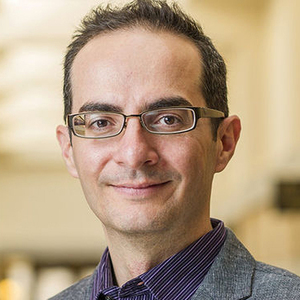Experts say use of political memes are a predictor of political violence

In a study of social media activity prior to Russia’s full-scale invasion of Ukraine, researchers at the University of Notre Dame say a sharp increase in politically salient imagery online — visual content designed to influence, dehumanize, manipulate and motivate audiences — was a predictor of the conflict.
With collaborators at Colby College and Kennesaw State University, the researchers collected post history from a select group of 989 Russian milbloggers – a term used for "military bloggers" who tend to post about military or war matters. The Russian group's content, which regularly focused on Russia and Ukraine relations, was posted to the social media platform Telegram between October 2015 and March 2023 to a total of more than 5.3 million posts and 3.2 million images.
The study is available at arxiv.org, an open-access resource for research prior to peer review.
Using a combination of subject matter expert and AI analysis, the study showed an 8,925 percent increase in the number of posts and a 5,352 percent increase in images posted by the same accounts two weeks prior to Russia’s full-scale invasion on Feb. 24, 2022.
“What we see is a massive campaign,” said Tim Weninger, the Frank M. Freimann Collegiate Professor of Engineering, director of Graduate Studies in Computer Science and Engineering at Notre Dame and co-author of the study. “That kind of rapid increase shows that, yes, there is predictive power to these social media campaigns. When we see a giant amount of propaganda being spun up on platforms like Telegram, it means something is impending. These are precursors to an eruption of violence.”
Weninger is an expert in disinformation and fake news. He has studied how dehumanization is used in the lead-up to hostilities and helped develop an early warning system to fight disinformation online.
To analyze data on such a massive scale, the research team used artificial intelligence, computer vision techniques and forensic analysis to identify a subset of posts leading up to and immediately following the invasion — a total of 144,048 images — all of them posted between Feb. 15 and March 15, 2022.
Subject matter experts in political violence and Russian-Ukraine relations, including Ernesto Verdeja, associate professor of peace studies and global politics at Notre Dame’s Kroc Institute for International Peace Studies and the Keough School of Global Affairs, performed a two-stage analysis of the images and identified politically salient narratives.

“Using this sophisticated AI system in conjunction with a group of experts on political violence and Russia and Ukraine, we were able to trace in near-real time not only the sharp rise in visual social media, but also the kinds of narratives that shape political discourse and drive instability,” said Verdeja.
Previous research has shown that politically salient image patterns — propaganda by way of visual content — have been used to sow discord and even threaten the integrity of democratic elections. But Weninger said the research team wondered if such activity could also be a real-time warning sign of politically motivated violent events.
In their analysis, the research team focused on three key functions of politically salient images in instability contexts, exploring how images may promote in-group solidarity, out-group vulnerability and epistemic insecurity.
“Wherever there is political instability, these are the kinds of stories that are told,” Weninger said. “So, the question is, ‘Do we see these stories told in propaganda efforts and social media?’ Indeed, we do. This is a definitive example — proof — of propaganda efforts on social media predicting violence.”
He added that it’s important to note not every instance of violent conflict will come with a barrage of social media beforehand, such as the current war between Israel and Hamas — in which case he saw no buildup of politically salient content prior to Hamas’ attack on Israel on Oct. 7, but observed an increase in the aftermath of that attack.
The study’s analysis of video and imagery is significant. “The emotional impact of a video or an image is so much more than a tweet,” he said, and a big reason why TikTok and YouTube Shorts are so popular.
“Modern social media is images and short videos,” Weninger said. “That’s what no one in the field was looking at — that's what we are working toward monitoring.”
Contact: Jessica Sieff, associate director of media relations, 574-631-3933, jsieff@nd.edu
Latest ND NewsWire
- Alumni Association awards 2024 Lennon Life PrizesThe Notre Dame Alumni Association recognized nine alumni clubs as recipients of the Lennon Life Prize — part of the Chuck and Joan Lennon Gospel of Life Initiative, a set of programs focused on encouraging the University’s dedicated network of clubs to uphold the value of life at all stages.
- 'Hybrid’ disaster response shows how localization saves livesThe earthquake that struck southwest Haiti in August 2021 killed thousands of people and left more than half a million seeking help. New research by a University of Notre Dame expert finds that the assessment of this disaster can serve as a model for evaluating future disasters and making life-saving improvements.
- Carter Snead testifies before US Senate Judiciary CommitteeO. Carter Snead, the Charles E. Rice Professor of Law and director of the de Nicola Center for Ethics and Culture at the University of Notre Dame, offered expert testimony on Wednesday (June 12) before the U.S. Senate Committee on the Judiciary.
- Into high waves and turbulence: Engineers deploy smart devices to improve hurricane forecastsForecasters’ ability to predict a hurricane’s intensity has lagged behind tracking its path because the forces driving the storm have been difficult and dangerous to measure — until now. “When we’re talking 150, 200-mph winds, with 30-foot waves, you don’t send a boat and crew out there to collect data,” said David Richter, associate professor of civil and environmental engineering and earth sciences. Richter is the lead investigator on an Office of Naval Research grant to send drones and other “smart” instruments into hurricanes to collect needed data.
- In memoriam: Winfried ‘Fred’ Dallmayr, professor emeritus of political scienceWinfried “Fred” Dallmayr, professor emeritus of political science at the University of Notre Dame, died June 5. He was 95.
- President Emeritus Rev. John I. Jenkins, C.S.C., honored with Sorin AwardIn recognition of a lifetime of service to the University of Notre Dame, culminating in his 19-year tenure as University President, Rev. John I. Jenkins, C.S.C., was presented with the 2024 Rev. Edward Frederick Sorin, C.S.C., Award on June 1 during the …













